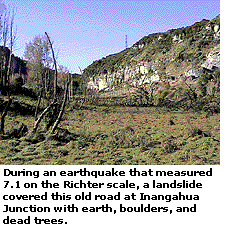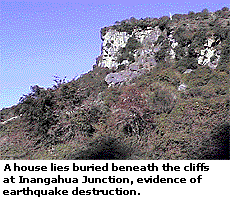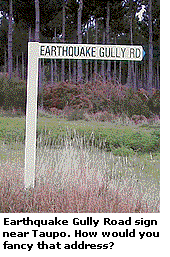 |
My Visits to Inangahua Junction and Earthquake Flat |
 |
|||
|
Earthquake Flat Walking south from Rotorua, I passed through Earthquake Flat, where a thousand earthquakes a year are monitored by seismologists, scientists who study earthquakes. At Taupo, I talked to seismologist Dr. Steve Sherburn, who works at the Institute of Geological and Nuclear Sciences (IGNS). He showed me how the seismographs that measure earthquakes work: "Sensors are located at points where the earth shakes. These sensors have a large weight inside, wrapped with a coil of wire. The weights are hung on springs and sit inside a magnet. When the earth shakes, the weight moves up and down on the spring. The coil moving in the magnetic field generates an electric current in the wire. The size of the current gives us a measurement of the movement that caused it. This is recorded by a pen that moves across a roll of paper. Information from the seismographs can provide warnings about earthquakes and volcanic eruptions." When Mount Ruapehu erupted in 1996 a large tremor was detected 36 hours before the eruption, allowing the IGNS to warn skiers to stay off the snow covered volcano. One of the places most at risk from earthquakes is Wellington, the capital of New Zealand. A motorway in the city was built on land that emerged from the sea after an earthquake in 1855. Presumably this land could disappear just as quickly as it formed. The Parliament House and the Parliament Library are only 400 meters away from a major fault line. These buildings, now about 100 years old, are built of brick, marble, and glass. To protect the buildings from earthquake damage, they have been separated from their foundations by 417 bearings of rubber, steel, and lead. The buildings can now sway 30 cm, and are safe in earthquakes up to 7.5 on the Richter Scale. . |

|
||||
|
|||||



